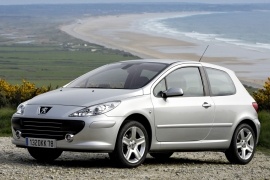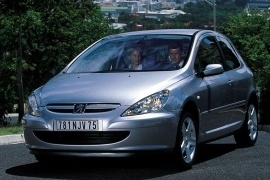PEUGEOT 307 3 Doors Models/Series Timeline, Specifications & Photos
First production year: 2001
Engines: Gasoline, Diesel
Body style: Hatchback
Peugeot introduced a mid-life cycle refresh for its compact-segment contender, the 307, in 2005 for all four versions: three- and five-door hatchback, coupe-cabriolet, and station-wagon.
The 307 was already a big success. It was named the "French Golf," and it proved to be a dependable car for its owners. In the three-door version, Peugeot offered it with a sportier version. But the modifications didn't stop just to the bumpers and wheels.
From the outside, the car featured a front fascia that resembled its bigger brother, the 407 sedan. It showed clear headlights and a smiling grille on the apron, under the black rubber bumper protection. The bumper got a cut-out for the exhaust in the back, while on the pre-facelifted version, the pipe was shorter and bent downward. For the GTI version, the 3-door 307 featured a roof spoiler in the back, bigger light-alloy wheels, and an oval exhaust tip.
Inside, the carmaker improved the material quality and the design for the center stack. It also added a new infotainment unit with a navigation system. Also, there were new switches that performed better than before. For the sportiest version, the car featured white dials and red needles inside the instrument cluster.
Under the hood, Peugeot improved its engine lineup. While it dropped the former 1.4-liter turbo-diesel, it left only three oil-burners in the offer. The most potent version offered 177 hp for the gasoline engine, unlike the 143 hp top-performer from the pre-facelifted version.
Peugeot replaced the aging 306 lineup in 2001 with the 307, and it was a big leap forward for the French carmaker, which attacked the all-mighty Golf on the European market.
Even though it couldn't match the Golf's capabilities in all the areas, the 307 offered a warmer interior than the German contender in the compact segment. Moreover, Peugeot offered a three-door bodywork for those who preferred a sportier-looking version.
The car came with a new design language that featured feline-inspired headlights. Its grille was narrow and crossed by a horizontal slat sporting the carmaker's badge in the middle. The carmaker placed a wider gap for cooling the engine on the lower side of the bumper flanked by the optional foglamps. From its profile, the 3-door 307 featured longer front doors and a pop-out rear window. The racked-forward C-pillars somehow resembled those from the Golf III, even though it competed against the Golf MkIV. At the back, the car's tailgate was flanked by corner-mounted taillights, limiting access to the trunk.
Inside, the carmaker installed a well-designed interior with carefully selected materials. The instrument cluster featured two large dials for the speedometer and tachometer. A pair of smaller gauges for the temperature and fuel level above the warning lamps' panel. The carmaker placed a silver plastic trim on the center stack that descended toward the center console, around the gear stick. But, like most of the Peugeots, the 307 featured comfortable seats with small side bolstering areas. As an option, depending on the engine, the carmaker offered high-bolstered seats. There was limited room for three passengers in the back, but just enough for two.
Under the hood, Peugeot placed a wide choice of engines ranging between an economical 1.4-liter turbo-diesel developed with Ford and a punchy 138 hp (140 PS) 2.0-liter gasoline powerplant. A GTi version fitted with a 175 hp (177 PS) was added later on.

